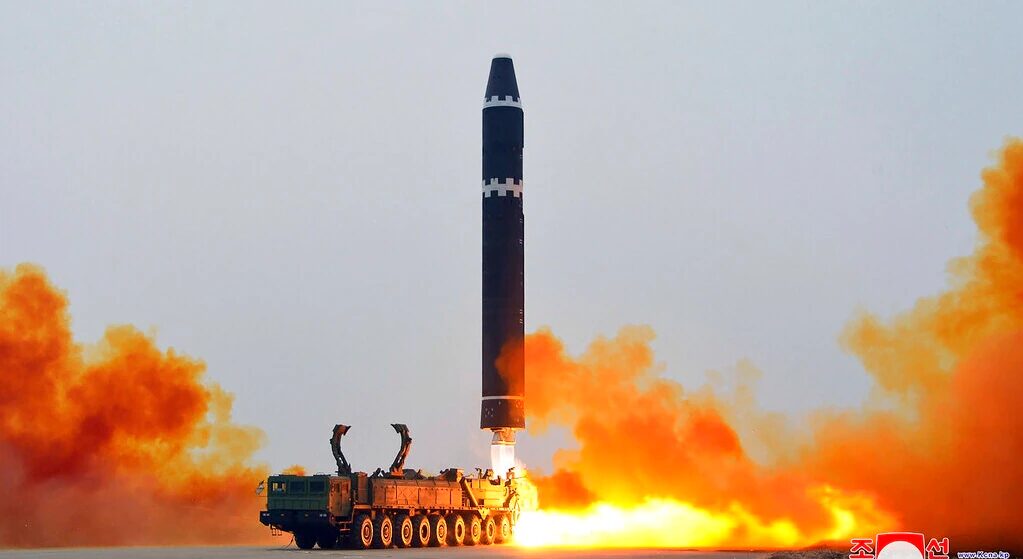This past Saturday, February 18th, in a blatant attempt to capture global attention, North Korea successfully launched its Hwasong-15, a land mobile solid fuel intercontinental ballistic missile with the capability to carry North Korean nuclear weapons. The Hwasong-15 presents a significant threat to the national security of the United States. On Saturday, the Hwasong-15 missile traveled in a high trajectory “lofted” at a top altitude of 5,760km, or 3,579 miles, for around 65 minutes, traveling over 980km, or 608 miles, before landing in Japan’s exclusive economic zone, about 200 kilometers (125 miles) west of Oshima island off of Hokkaido. The Hwasong-15 use of solid fuel makes readiness and reliability significantly more efficient than its liquid fueled ICBM counterparts, the Hwasong-14 and Hwasong-17. Today’s nuclear-armed powers all possess solid fuel missiles for optimal reliability, readiness, and survivable second and third strike capability that can be fueled from the point of manufacture and can sustain long periods of time without replenishment.
The Hwasong 15, owing to its truck-based mobility and solid fuel capability can be mass-produced by North Korea at a much lower cost and efficiency than liquid fueled ICBMs with a capacity that inherently has credible second- and third-strike capability, elevating North Korea’s status as a nuclear power and a significant nuclear threat to the United States. It has a range of 13,000km (8,077 miles), allowing it to reach most locations within US territories including Guam, Hawaii, and the Continental US, and carries a 1,000kg (2,204lb) conventional weapons payload or nuclear payloads. The Hwasong-15 has a significantly smaller footprint for detection, as the launchers can be wheeled to numerous predetermined launch sites and be dispersed both above ground and underground, further challenging left of launch targeting efforts and kill chains to take out the launchers before they fire.
The Hwasong-15 adds to the North Korean ICBM capacity and capability by providing a quick response ICBM that can be transported and fired on demand with range enough to strike the United States Homeland and Guam. The North Korean Ballistic Missile inventory includes:
· Hwasong-17, a liquid fueled ICBM with a range of 15,000km (9320 miles) capable of reaching the eastern United States
· Hwasong-15, a solid fuel ICBM with a range of 14,000km (8699 miles) capable of reaching Washington, DC.
· Hwasong-14, a liquid fueled ICBM with a range of around 10,400km (6462 miles), capable of targeting the Midwest United States.
· Hwasong-13, a liquid fueled ICBM with a range of around 8,000km (4970 Miles) capable of targeting Guam and Hawaii.
· Hwasong-12, a liquid-fueled IRBM with a range of around 4,000km (2485 miles) capable of targeting Guam
· Hwasong-8 Hypersonic Glide Vehicle (HGV), an IRBM with a range of 3700km, capable of targeting Guam.
North Korea has launched six ICBMs to date, the Hwasong-15 marking the first ICBM missile launched this year. North Korea launched 95 ballistic and cruise missiles in 2022, and 10 ballistic missiles were launched in 2021.
To defeat this North Korean missile capable of striking the United States; USNORTHCOM currently has 44 Ground-based Interceptors (GBIs) that are made up of three different generations that each have various multiple shot doctrines. A new interceptor system intended to supplement and eventually replace these GBIs is the Next Generation Interceptor (NGI), with projected limited first operational capability beginning in 2028. INDOPACOM currently has a THAAD battery in Guam and an Aegis BMD Ship on standby to defend Guam from the North Korean Hwasong missile threats. It is important to note that the state of Hawaii remains without an operational land-based missile defense system on its islands, instead relying on a long range shot from the 44 GBIs.
It is paramount to maximize what the nation can do with the current defensive capabilities it has – this starts with increasing the Service Life Extension Program (SLEP) program for the all of the existing GBIs, producing more SM-3 Block IIAs that can be placed on Guam, Hawaii, and on Aegis BMD ships, increasing production of THAAD interceptors, and continuing to test the SM-3 Block IIA against ICBMs, test the SM-3 Block IIA, SM-6, and the THAAD interceptor against the inventory of Hwasong ICBMs including hypersonic capability.
North Korea is showing progress that could soon overmatch current US Missile Defense capabilities with mass effects. The bolstering of current missile defense capabilities on Guam, on Hawaii, on Alaska, and on the West Coast of the United States is required to ensure the fully integrated deterrence and defense of our allies, and for the enhanced National Security of the United States.
At the strategic level, China is North Korea’s only ally, and it continues to enable the North Korean missile program. China and North Korea are colluding to apply strategic pressure on the United States and our allies within the Indo-Pacific. We must defeat their strategic intentions with renewed efforts to develop and field comprehensive Missile Defense capabilities.
The most promising avenue to achieve strategic overmatch against North Korea, is the rapid development and deployment of space-based missile defense capabilities including sensors, and both kinetic and non-kinetic effectors. Space-based capabilities are absolutely critical to the defense of the United States and our allies across the Indo-Pacific and in Europe. Time is of the essence and North Korea is on the march lockstep with China.
Time is of the essence.

